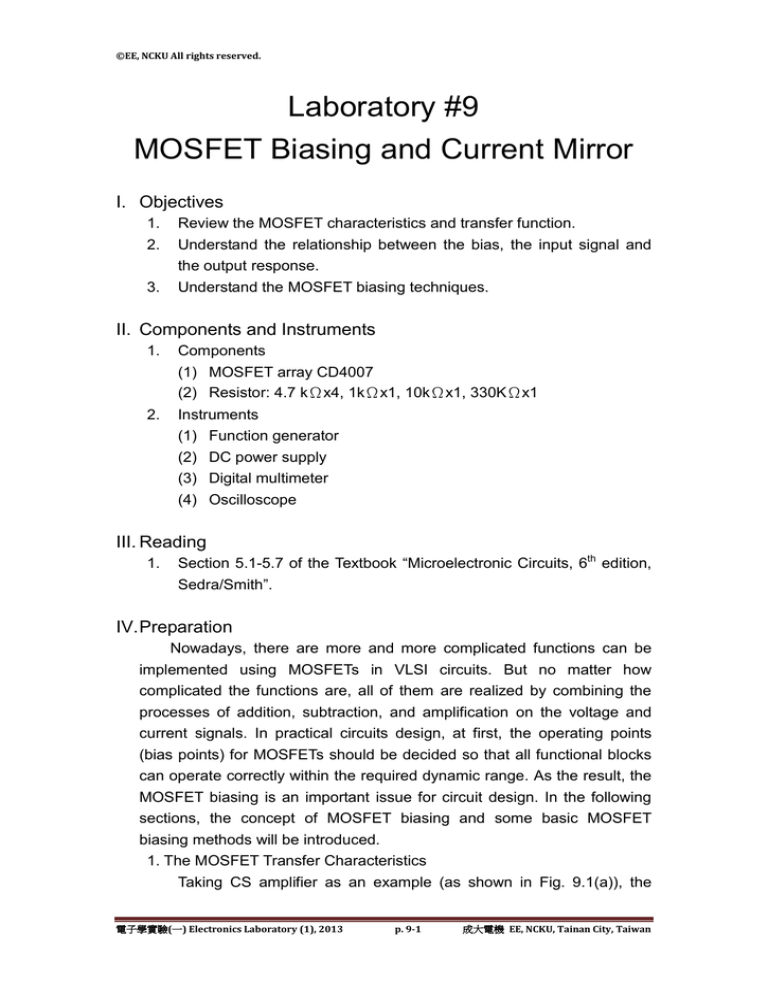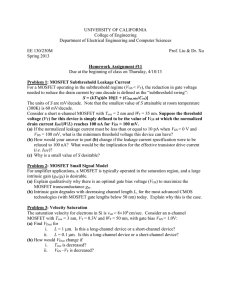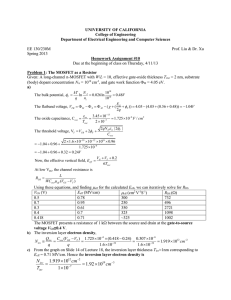
© EE, NCKU All rights reserved.
Laboratory #9
MOSFET Biasing and Current Mirror
I. Objectives
1.
2.
Review the MOSFET characteristics and transfer function.
Understand the relationship between the bias, the input signal and
the output response.
3.
Understand the MOSFET biasing techniques.
II. Components and Instruments
1.
Components
(1) MOSFET array CD4007
(2) Resistor: 4.7 kΩx4, 1kΩx1, 10kΩx1, 330KΩx1
2.
Instruments
(1) Function generator
(2) DC power supply
(3) Digital multimeter
(4) Oscilloscope
III. Reading
1.
Section 5.1-5.7 of the Textbook “Microelectronic Circuits, 6th edition,
Sedra/Smith”.
IV. Preparation
Nowadays, there are more and more complicated functions can be
implemented using MOSFETs in VLSI circuits. But no matter how
complicated the functions are, all of them are realized by combining the
processes of addition, subtraction, and amplification on the voltage and
current signals. In practical circuits design, at first, the operating points
(bias points) for MOSFETs should be decided so that all functional blocks
can operate correctly within the required dynamic range. As the result, the
MOSFET biasing is an important issue for circuit design. In the following
sections, the concept of MOSFET biasing and some basic MOSFET
biasing methods will be introduced.
1. The MOSFET Transfer Characteristics
Taking CS amplifier as an example (as shown in Fig. 9.1(a)), the
電子學實驗(一) Electronics Laboratory (1), 2013
p. 9-1
成大電機 EE, NCKU, Tainan City, Taiwan
© EE, NCKU All rights reserved.
transfer function of vDS vs. vGS can be derived from Fig. 9.1(b). If there is
no voltage applied to the gate (vGS=0), then no current will flow through RD
and vDS is equal to vDD. When vGS exceeds the threshold voltage Vt, the
current begins to increase and vDS becomes lower because of the higher
voltage drop on RD. Based on the relationship between vGS, vDS and iD in
saturation region, the operating point will move from point A to point B.
The MOSFET continues operating in saturation region until vGS>vDS+Vt.
After point B, the output voltage decrease slowly toward zero. Here we
identify a particular operating point C as VGS=VDD. The corresponding
output voltage VOC will usually be very small. This point-by-point
determination of the transfer characteristics results in the transfer curve
shown in Fig. 9.1 (c).
VDD
ID
RD
VDS
VGS
(a)
(b)
(c)
Fig. 9.1 (a) NMOS with a load resistor RD (b) iD vs. vDS under different vGS
(c) NMOS transfer function.
The MOSFET is biased in different regions for different applications.
For example, if the MOSFET is used to provide the function of
amplification, it should be biased in the saturation region because of its
maximal slope (which means maximal gain). After the biasing voltage of
VGS has been set, small signal vgs is applied to the input, the output
response of vDS can then be observed at the drain of MOSFET. As shown
in Fig. 9.2, the input signal is the combination of VGS and vgs.
VDD
ID
VDD
RD
ID
RD
Applying signal
vDS
VDS
vgs
vGS
VGS
signal
response
vGS = VGS + vgs
vDS = VDS + vds
iD = ID + id
bias
VGS
Bias
Bias and signal
Fig. 9.2 Combination of bias and signal.
電子學實驗(一) Electronics Laboratory (1), 2013
p. 9-2
成大電機 EE, NCKU, Tainan City, Taiwan
© EE, NCKU All rights reserved.
2. Biasing in MOSFET Amplifier Circuits
As mentioned in the previous section, the establishment of an
appropriate DC operating point is an essential step in the design of a
MOSFET amplifier circuit. This is the step known as biasing design. An
appropriate DC operating point or bias point should ensure the operation
in the saturation region for all expected input-signal levels, which is
characterized by a stable and predictable DC drain current ID, and by a
DC drain-to-source voltage VDS that.
(1) Biasing by fixed VGS
The most straightforward approach to bias a MOSFET is to fix its
gate-to-source voltage VGS at the required value and so the desired ID.
This voltage value can simply be derived from the supply voltage VDD
through the use of an appropriate voltage divider. Alternatively, it can
be derived from any another suitable reference voltage available in
the system. However, this is not a good technique in biasing a
MOSFET. Recall that,
ID
1
W
nCox VGS Vt 2 …… (Eq. 9.1)
2
L
and note that the values of Vt, Cox and W/L vary widely for the same
devices, since the process variation. Furthermore, both Vt and μn is
temperature-dependent, and the ID is thus temperature-sensitive. To
emphasize that MOSFET biasing by fixed VGS is not a good technique,
here in Fig. 9.3, we show the extreme case of iD-vGS characteristic
curves of two same type MOSFETs in a batch. As the value of VGS is
fixed, it will correspond to different drain current due to the process
variation.
Fig. 9.3 The use of fixed bias (constant VGS) can result in
a large variation in the value of ID.
電子學實驗(一) Electronics Laboratory (1), 2013
p. 9-3
成大電機 EE, NCKU, Tainan City, Taiwan
© EE, NCKU All rights reserved.
(2) Biasing by fixing VG with source degeneration
A better biasing technique for discrete MOSFET circuits is to
connect a resistor with the source lead while fixing the gate voltage
VG, as shown in Fig. 9.4 (a). For this circuit we can write
VG VGS RS I D …… (Eq. 9.2)
If VG is much greater than VGS, ID will then be determined by the
values of VG and RS. However, even if VG is not much larger than VGS,
the resistor RS provides negative feedback and stabilize the value of
the bias current ID. This could be understood that since VG is constant,
VGS will decrease as ID increases, and this in turn results in a
decrease in ID. This negative feedback function of RS gives it the
name degeneration resistor. Fig. 9.4 (b) provides a graphical
illustration of the effectiveness of this biasing scheme, where the
intersection of the straight line of (Eq. 9.2) and the iD-vGS
characteristic curve provides the coordinates of the bias point.
Compared to the case of fixed VGS, the variation in ID is much smaller.
Also, note that the variation decreases as VG and RS are made larger,
since this results in flatter slope.
Fig. 9.4 Biasing using a fixed voltage with degeneration resistance
(a) basic arrangement; (b) reduced variability in ID
(3) Biasing with drain-to-gate feedback resistor
Another simple MOSFET biasing circuit is to utilize a feedback
resistor to connect between the drain and the gate as shown in Fig.
9.5. Here the large feedback resistance RG (usually in range of MΩ)
forces the DC voltage at the gate to be equal to that at the drain
(because IG=0). For this circuit, it can be expressed as follows.
VDD VGS I D RD …… (Eq. 9.3)
which is similar to Eq. 9.2, and it has the same mechanism as the
電子學實驗(一) Electronics Laboratory (1), 2013
p. 9-4
成大電機 EE, NCKU, Tainan City, Taiwan
© EE, NCKU All rights reserved.
biasing scheme discussed in Fig. 9.4 (a). If ID changes for some
reason, say increases, VGS will decrease according to Eq. 9.3. Thus
the negative feedback function or degeneration provided by RG works
to keep the value of ID as constant as possible.
Fig. 9.5 Biasing MOSFET using feedback resistance, RG
The biasing circuit of Fig. 9.5 can directly be utilized in CS
amplifier. Apply the input voltage signal to the gate via a coupling
capacitor for not disturbing the DC bias conditions, and the amplified
output signal at the drain can also be coupled to another part of the
circuit via another capacitor.
(4) Biasing using current mirror
The most effective scheme for biasing a MOSFET amplifier is the
using of a constant-current source, which is as shown in Fig. 9.6 (a).
Resistor RD establishes an appropriate DC voltage at the drain to
allow for the required output signal swing while ensuring that the
transistor always remains in the saturation region.
A circuit for implementing the constant-current source I is shown
in Fig. 9.6 (b). The key-point of the circuit is the transistor Q1, whose
drain is shorted to its gate and is thus operated in the saturation
region, such that
1 W
2
I D1 k n ' VGS Vt …… (Eq. 9.4)
2 L 1
In Eq. 9.4, we have neglected channel-length modulation. The drain
current of Q1 is supplied by VDD through resistor R. Since the gate
current is zero, the drain current of Q1 will be
I D1 I REF
VDD VGS
…… (Eq. 9.5)
R
where the current through R could be considered as the reference
電子學實驗(一) Electronics Laboratory (1), 2013
p. 9-5
成大電機 EE, NCKU, Tainan City, Taiwan
© EE, NCKU All rights reserved.
current of the current source and denoted as IREF. Eq. 9.4 and Eq. 9.5
can be used to determine the value of R, once the parameter values
of Q1 and the desired value for IREF are given. Now consider the
transistor Q2, which has the same VGS as Q1, its drain current can be
expressed as Eq. 9.6 if Q2 is ensured to be operated in saturation
region.
1 W
2
I I D 2 k n ' VGS Vt …… (Eq. 9.6)
2 L 2
In Eq. 9.6, we have neglected channel-length modulation. Eq. 9.5 and
Eq. 9.6 enables us to relate the current I to the reference current I REF,
W / L 2
I I REF
…… (Eq. 9.7)
W / L 1
This circuit, which is known as a current mirror, is very popular in the
design of IC MOSFET amplifiers.
Fig. 9.6 (a) MOSFET biasing using a constant-current source I.
(b) Constant-current source I implemented by current mirror.
電子學實驗(一) Electronics Laboratory (1), 2013
p. 9-6
成大電機 EE, NCKU, Tainan City, Taiwan
© EE, NCKU All rights reserved.
V. Explorations
The layout and connections of CD4007 MOS array are shown in Fig. 9.7.
CD4007 consists of 6 transistors, 3 are p-channel and another 3 are n-channel,
which are connected in some nodes in order to reduce the number of IC pins
required, but otherwise fairly flexible.
1
14
2
13
3
12
4
11
5
10
6
9
7
8
Fig. 9.7 CD4007 MOSFET array
NOTE: Pin14 must be connected to the most positive voltage, and pin
7 to the most negative. For the sake of safety, maintain the voltage
between pin 7 and pin 14 at or below 16V to avoid internal voltage
breakdown. Make sure you turn off the power supply before
changing any circuit connection.
DVM: Digital Voltage Meter
DCM: Digital Current Meter
DMM: Digital Multi-Meter
1.
Transfer curve of NMOS CS amplifier
+12V
RD
Vo
VI
Fig. 9.8 CS MOSFET amplifier
電子學實驗(一) Electronics Laboratory (1), 2013
p. 9-7
成大電機 EE, NCKU, Tainan City, Taiwan
© EE, NCKU All rights reserved.
(1) Use the CD4007 array to assemble the circuit as shown in Fig.
9.8. Choose the resistor RD to be 1kΩ. Be sure to connect the
substrates correctly to the supplies as indicated, i.e. pin14 to
+12V, pin7 to the ground.
(2) At first, apply a DC voltage of VI=0V to the gate so that the
NMOS can be fixed-biased. Record the output voltage VO in
Table 9.1.
(3) Keep increasing the input voltage VI until VO begins to decrease,
then record the values of VI and VO. According to Table 9.1, alter
the input voltage VI and record the corresponding VO until you
finish the tables.
(4) Further, change RD into 10kΩ and 330kΩ, repeating steps (1)-(3),
to finish Tables 9.2 and 9.3 respectively.
2.
PMOS Current Mirror
+5V
Q1
A
Q2
B
RB
10kΩ
R1B
4.7kΩ
C
Q3
D
R1A
4.7kΩ
E
R2B
4.7kΩ
R2A
4.7kΩ
Fig. 9.9 A PMOS current mirror
(1) Assemble the PMOS current mirror as shown in Fig. 9.9.
(2) Use the DVM to measure the voltages at nodes A, B, C, D, E.
Measure the current transfer ratios from input (A) to outputs (B
and D) and record them in Table 9.4.
(3) Short R1A, noting the old and new values, and particularly the
change in voltage.
(4) Remove R1A and R2A, and short nodes B and D. Record the
current flow through point A and point B in Table 9.4 respectively.
VI. Reference
1.
2.
3.
“Laboratory manual for microelectronic circuits”, third edition.
“Microelectronic circuit”, sixth edition.
“CD4007UBE” datasheet, Texas Instruments.
(http://focus.ti.com/lit/ds/symlink/cd4007ub.pdf)
電子學實驗(一) Electronics Laboratory (1), 2013
p. 9-8
成大電機 EE, NCKU, Tainan City, Taiwan
© EE, NCKU All rights reserved.
Laboratory #9 Pre-lab
Class:
Name:
Student ID:
Problem 1 (PSPICE simulation)
Assemble the circuit as shown in Fig. 9.8 with RD=10kΩ, and use DC
analysis to sweep VI from 0V to 15V. Plot the transfer function of VO vs. VI.
Problem 2 (PSPICE simulation)
Assemble the circuit as shown in Fig. 9.9. Use the transient analysis
to measure the voltage and current values at nodes A, B, C, D, and E.
電子學實驗(一) Electronics Laboratory (1), 2013
p. 9-9
成大電機 EE, NCKU, Tainan City, Taiwan
© EE, NCKU All rights reserved.
Laboratory #9 Report
Class:
Name:
Student ID:
Exploration 1
RD = 1kΩ
VI
0V
Vt=
2V
2.5V
3.0V
3.5V
9.0V
10V
11V
12V
4.0V
4.5V
5.0V
5.5V
6.0V
4.0V
4.5V
5.0V
5.5V
6.0V
4.0V
4.5V
5.0V
5.5V
6.0V
VO
VI
7.0V
8.0V
VO
Table 9.1
RD = 10kΩ
VI
0V
Vt=
2V
2.5V
3.0V
3.5V
9.0V
10V
11V
12V
VO
VI
7.0V
8.0V
VO
Table 9.2
RD = 330kΩ
VI
0V
Vt=
2V
2.5V
3.0V
3.5V
9.0V
10V
11V
12V
VO
VI
7.0V
8.0V
VO
Table 9.3
Exploration 2
Bias point measurement
Node
A
B
C
D
E
Voltage
IB
IA
Current transfer ratio
ID
IA
IB
IA
Current transfer ratio (with R1A shorting)
ID
IA
Current mirror (remove RXA and connecting B and D)
IA
電子學實驗(一) Electronics Laboratory (1), 2013
Taiwan
IB
p. 9-10
成大電機 EE, NCKU, Tainan City,
© EE, NCKU All rights reserved.
Table 9.4
Problem 1
Use MATLAB or Excel to plot the VO vs. VI transfer curve according
your experimental results. (For Exploration 1)
Problem 2
In Exploration 2, after removing R1A and R2A, does the current IB
become two times of IA? If not, try to figure out the reasons.
Conclusion
電子學實驗(一) Electronics Laboratory (1), 2013
Taiwan
p. 9-11
成大電機 EE, NCKU, Tainan City,






